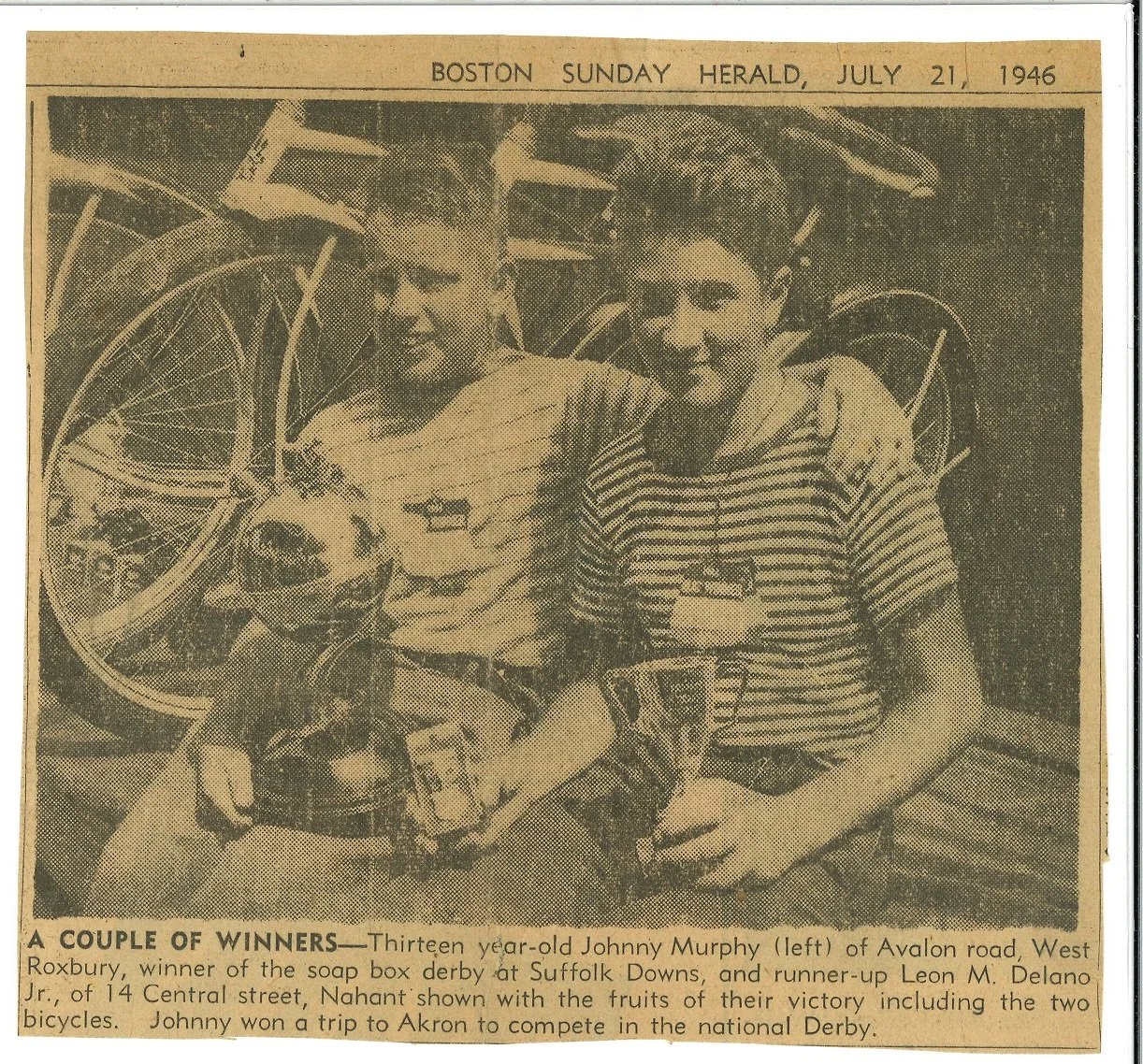The first Soap Box Derby held in Nahant was in 1961. Leon Delano and Clayton Gates were part of the start-up committee. Leon had done his share of Soap Box Derby racing, placing second in the race held at Suffolk Downs in 1946.
1946 - Leon Delano of Nahant, Revere Soap Box Derby Runner Up
The starting ramp was in front of the Cyr home at 86 Little Nahant Road. Young Jimmy Cyr was one of the race participants along with John Magro, Mark Dougherty, Skipper Lewis, and Sandy Croft – to name a few. (If you know the names of any other racers for that year, we’d love to hear from you.)
1961 - Jim Cyr
1961 - Winner Thomas McCarthy
1961 - Soap Box Derby contestants
“The Thrill on the Hill” was run in Nahant for many years on Memorial Day Weekend, primarily in Little Nahant (though there were a few years that the race took place on Nahant Road with the starting ramp at the top of the hill by Forty Steps Beach.) The Boy Scouts were typically the organizers of this event, though participation was open to all children in Nahant.
2005, 2006, 2007 T shirts can be purchased at our gift shop
2003 - Soap Box Derby Starting Line Little Nahant Road, Photo by Lisa Doyle
2007 - Girls participating in Derby, Little Nahant Road. Photo by Jonathon M. Whitmore, Lynn Item
History of National Soap Box Derby
The Soap Box Derby began in Ohio in 1933 when Myron E. Scott, a photographer for the Dayton Daily News, came upon a group of boys racing down a hill in homemade cars. Mr. Scott noticed that the cars were made from wooden soap crates and had four wheels, so he called their race a Soap Box Derby.
Mr. Scott talked his boss into sponsoring an organized series of soap box derbies through the summer of 1933 and into the next year. In 1934, 300 children participated watched by about 40,000 spectators. By 1935, the General Motors Chevrolet division agreed to sponsor an annual derby event. That is when the official race left Dayton and moved to Akron, much to the relief of the folks of Dayton. The following year a permanent track was built for the derbies.
Derby Downs was built in Akron in 1935 with the help of the Works Progression Administration (WPA), part of President Franklin D. Roosevelt’s NEW DEAL program established to help repair the economic destruction caused by the Great Depression. It’s remarkable to realize that the children’s races helped create jobs and brought a measure of happiness during these bleak years.
To this day, with the exception of four years during World War II and then again in 2019-2020 due to COVID – the race has taken place every year. The annual Derby is still run at Derby Downs in Akron, Ohio, but has become an international competition with girls and boys from all over the world participating. 1971 was the first year that included girls, and 1975 was the first year, of many, where a girl was the winner.
Car design
The racecars have strict guidelines as to how they are built and never have a motor.
Cars are no longer made from soap boxes. They have to be built to meet rule specifications, but still without motors. Design and construction of a Soap Box Derby car usually reflected the skills of the kid who built it, and as time passed each iteration with each new generation benefited from the previous on how a car would look. Before the introduction of kit cars in 1976, all cars were one-of-a-kind creations, some looking particularly unique in their experimentation with form and function. Like any evolutionary process, if innovations were successful at the track they were passed on to future designs.
Rule change highlights by year
1934 – Cost limit of $10 per car, excluding wheels, axles
1936 – Bicycle wheels prohibited
1937 – Only 12-inch (30 centimeter) solid rubber wheels permitted
1939 – Weight limit of car alone set at 150 pounds (68 kg)
1940 – Added weight not part of the car's construction prohibited
1947 – Use of graphite on car or on driver's person prohibited
1948 – Tiller steering and windscreens prohibited
1949 – Use of power tools to construct car prohibited
1950 – After much protest, power tool use permitted
1950 – Laminate construction and pre-1948 wheels banned
1950 – Removable cockpit seat backs required
1951 – After much protest, laminate car construction permitted
1953 – Vertical steering columns prohibited
1954 – Wheel tampering i.e. drilling, painting prohibited
1957 – No evidence of tire or bearing tampering being tolerated
1958 – $15 cost limit per car; wheel enclosures of any kind prohibited
1959 – Use of lead anywhere in vehicle prohibited
1961 – Driver's eyes must be above front cowling when racing
1962 – Use of aluminum and sheet metal prohibited
1963 – Ownership of top-nine cars at All-American passed to AASBD
1964 – Lay-back or lay-down cars permitted
1966 – $30 cost limit per car, excluding wheels, axles and steering
1968 – Cable turnbuckles must be outside of car
1971 – Girls permitted to race; needle-nose cars prohibited
1972 – Steering column above car body prohibited
1973 – Wheels must be calibrated
1976 – Windscreens on new Junior Division kits cars permitted
1977 – Windscreens on all racers prohibited
1992 – Stock kit racer made mandatory
1994 – Super Stock kit racer made mandatory
2000 – Masters kit racer made mandatory

